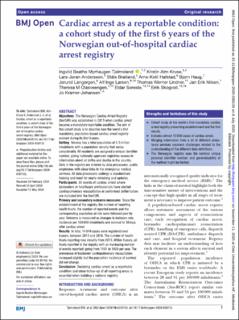| dc.contributor.author | Tjelmeland Myrhaugen, Ingvild Beathe | |
| dc.contributor.author | Alm-Kruse, Kristin | |
| dc.contributor.author | Andersson, Lars-Jøran | |
| dc.contributor.author | Bratland, Ståle | |
| dc.contributor.author | Hafstad, Arne Ketil | |
| dc.contributor.author | Haug, Bjørn | |
| dc.contributor.author | Langørgen, Jørund | |
| dc.contributor.author | Larsen, Alf Inge | |
| dc.contributor.author | Lindner, Thomas Werner | |
| dc.contributor.author | Nilsen, Jan Erik | |
| dc.contributor.author | Olasveengen, Theresa Mariero | |
| dc.contributor.author | Søreide, Eldar | |
| dc.contributor.author | Skogvoll, Eirik | |
| dc.contributor.author | Kramer-Johansen, Jo | |
| dc.date.accessioned | 2020-11-20T10:24:40Z | |
| dc.date.available | 2020-11-20T10:24:40Z | |
| dc.date.created | 2020-08-06T08:46:47Z | |
| dc.date.issued | 2020 | |
| dc.identifier.citation | BMJ Open. 2020, 10 (7), . | en_US |
| dc.identifier.issn | 2044-6055 | |
| dc.identifier.uri | https://hdl.handle.net/11250/2688869 | |
| dc.description.abstract | Objectives The Norwegian Cardiac Arrest Registry (NorCAR) was established in 2013 when cardiac arrest became a mandatory reportable condition. The aim of this cohort study is to describe how the world’s first mandatory, population-based cardiac arrest registry evolved during its first 6 years.
Setting Norway has a total population of 5.3 million inhabitants with a population density that varies considerably. All residents are assigned a unique identifier number, giving nationally approved registries access to information about all births and deaths in the country. Data in the registry are entered by data processors; public employees with close links to the emergency medical services. All data processors undergo a standardised training and meet for yearly retraining and updates.
Participants All events of cardiac arrest where bystanders or healthcare professionals have started cardiopulmonary resuscitation or performed defibrillation are included into the NorCAR.
Primary and secondary outcome measures Since the establishment of the registry, the number of reporting health trusts, the number of reported events and the corresponding population at risk were followed year by year. Outcome is measured as changes in inclusion rate, incidence per 100 000 inhabitants and survival to 30 days after cardiac arrest.
Results In total, 14 849 cases were registered over 6 years, between 2013 and 2018. The number of health trusts reporting rose steadily from 2013. Within 3 years, all trusts reported to the registry with an increasing number of events reported; going from 1101 to 3400 per year. The prevalence of bystander cardiopulmonary resuscitation increased slightly, but the population incidence of survival did not change.
Conclusion Declaring cardiac arrest as a reportable condition and close follow-up of all reporting areas is essential when building a national registry. | en_US |
| dc.language.iso | eng | en_US |
| dc.publisher | BioMed Central | en_US |
| dc.rights | Navngivelse-Ikkekommersiell 4.0 Internasjonal | * |
| dc.rights.uri | http://creativecommons.org/licenses/by-nc/4.0/deed.no | * |
| dc.title | Cardiac arrest as a reportable condition: A cohort study of the first 6 years of the Norwegian out-of-hospital cardiac arrest registry | en_US |
| dc.type | Peer reviewed | en_US |
| dc.type | Journal article | en_US |
| dc.description.version | publishedVersion | en_US |
| dc.source.pagenumber | 0 | en_US |
| dc.source.volume | 10 | en_US |
| dc.source.journal | BMJ Open | en_US |
| dc.source.issue | 7 | en_US |
| dc.identifier.doi | 10.1136/bmjopen-2020-038133 | |
| dc.identifier.cristin | 1821946 | |
| dc.description.localcode | This is an open access article distributed in accordance with the Creative Commons Attribution Non Commercial (CC BY-NC 4.0) license, which permits others to distribute, remix, adapt, build upon this work non-commercially, and license their derivative works on different terms, provided the original work is properly cited, appropriate credit is given, any changes made indicated, and the use is non-commercial. See: http://creativecommons.org/licenses/by-nc/4.0/. | en_US |
| cristin.ispublished | true | |
| cristin.fulltext | original | |
| cristin.qualitycode | 1 | |

